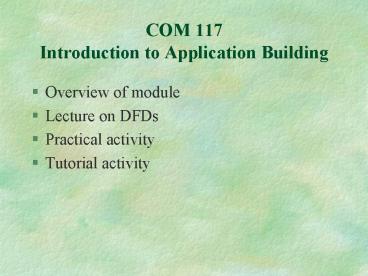COM 117 Introduction to Application Building - PowerPoint PPT Presentation
1 / 27
Title:
COM 117 Introduction to Application Building
Description:
Example: Hairdressing Salon Level 1 Physical DFD. Summary. S.S.A.D.M. ... Uses different techniques to model a system. Data Flow Diagrams ... – PowerPoint PPT presentation
Number of Views:54
Avg rating:3.0/5.0
Title: COM 117 Introduction to Application Building
1
COM 117 Introduction to Application Building
- Overview of module
- Lecture on DFDs
- Practical activity
- Tutorial activity
2
Timetable
3
(No Transcript)
4
Data Flow Diagrams
5
Introduction
- SSADM
- What is a Data Flow Diagram?
- Why do we use DFDs?
- Levelling
- Conventions
- Decomposition and Abstraction
- The Elements
- Process and Data Stores
- Outside Entity
- Data Flow
- The Levels
- Rules
- The Procedure for Constructing DFDs
- The Document Flow Diagram
- The Context Diagram
- Draw the external entities and data stores
- Level 1 Physical DFD
- Example Hairdressing Salon Level 1 Physical DFD
- Summary
6
S.S.A.D.M.
- S.S.A.D.M. - Structured Systems Analysis and
Design Method - Uses different techniques to model a system
- Data Flow Diagrams
- Entity Relational Model (Logical Data Stores)
- Normalisation
7
What is a Data Flow Diagram?
- Known as DFDs
- A way to model a real world situation
- They model the real world situation which aids
discussion and clarity amongst users, analysts
and designers.
8
Why do we use DFDs?
- It is a way of taking the physical view and
converting it into a logical view. - The physical view - all documents involved
- The logical view - the data they contain
- Their main purpose is to communicate with the
user, the analysts understanding of the scope of
the required system
9
Levelling
- Levels determine the amount of information shown
- Context diagrams show environment
- Each level shows more info. than the last
- DFDs are expanded or decomposed into levels.
- Separating each process into sub processes
- Uncovers more and more detail
10
Conventions
- Balancing
- Process at lower level should have identical data
flows if they flow out of a process - Modelling Data Stores
- Only use DATA STORES used within this process on
the diagram - Numbering
- 1 - 1.1 - 1.1.1
- 1.2 - 1.2.1
- Labels
- Should carry as much meaning as possible
11
Decomposition and Abstraction
- Decomposition - Divide and subdivide into
manageable size problems - Abstraction - Concentrate on the important issues
and ignore the irrelevant
12
The Elements
- The four main elements of DFDs notation
- Data Flows, with a label to indicate what data is
flowing - Processes, that handle the data
- Data stores, within the system (diary, filing
cabinet or computer file) - Outside entities, outside sources of data
13
Process and Data Stores
- A process is made up of
- Data Stores
Destination (Place or Name)
Process Number
Process description Should be descriptive,
starting with a verb.
Can be M for manual or D for computer base data
stores.
Name of Store
M1
14
Outside Entity
- Is anything outside the system that is of
interest to the system. Can be a person, a
company or another system.
Customer a
Outside entity shows the Name and a lowercase
alpha character is used to uniquely identify it.
Customer a
If an outside entity is repeated for the purpose
of neat layout a line is added across the top.
15
Data Flow
- Is shown by a line with an arrowhead, indicating
the direction of the flow of data. Each data
flow should be named to indicate what data is
being passed. Nouns or adjectives only no verbs
are permitted.
16
The Levels
- Context - Overview - contains only one process
- Level 1 - Utilises all four elements
- Level 2 - A breakdown of a level 1 process
- Level 3 - A breakdown of a level 2 process
- There is no rule as to how many levels of DFD
that can be used.
17
Rules
- Sequence not important - getting the Process
correct is - Context or Level 0 - Identifies the system/
boundary/External Links - Level 1 - Overview of function
- Level 2 - Breakdown to Understand
- Hard to know where to stop
- Rule of Thumb
- If there are more than 8 data flows break it
- Process of Identifying major Processes
18
(No Transcript)
19
(No Transcript)
20
(No Transcript)
21
(No Transcript)
22
(No Transcript)
23
(No Transcript)
24
(No Transcript)
25
Process 3 Level 2
3
Hair/Reception
Client a
Clie a
3.1
Hairdresser
Appointment Details
Conduct Appointment
Hair Details
M2
Diary
3.2
Hairdresser
Inform Reception
Change of Hair Details
3.3
Receptionist
Complete Appointment
M3
Client Card
26
Naming of DFD processes
27
Summary
SSADM What a DFD is Why we use them The
conventions What the elements are Example

